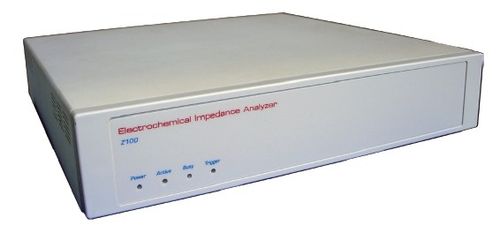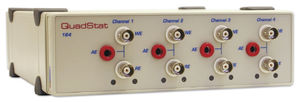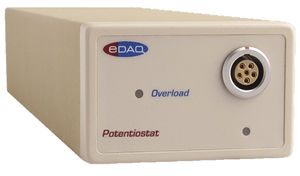
Electrical network analyzer ERZ100power qualityimpedancebenchtop
Add to favorites
Compare this product
Characteristics
- Application domain
- for electrical networks
- Measured value
- power quality, impedance
- Configuration
- benchtop
Description
The Electrochemical Impedance Analyzer is desigend to perform electrochemical impedance spectroscopy (EIS) with the addition of an EA163 Potentiostat (up to 100 kHz).
EIS applies a small, non-destructive, AC waveform to a sample and measures the subsequent attenuation and phase shift of the signal. The experiment is repeated over a range of frequencies (typically up to 10 per decade) and the results are modelled as a combination of resistors and capacitors (and other electrical components) which, in turn, can be interpreted as physicochemical phenonena. In particular, a sample that has a layered stucture can have the electrical conductivity of the layers determined, and if the diectric constant(s) of the sample are known then the thickness of the layers can also be determined.
EIS is also often used in the characterisation of surface processes, such as corrosion.
Citation
Performance of conducting polymer electrodes for stimulating neuroprosthetics. R A Green, P B Matteucci, R T Hassarati, B Giraud, C W D Dodds, S Chen, P J Byrnes-Preston, G J Suaning, L A Poole-Warren and N H Lovell, Journal of Neural Engineering, 10, 016009. DOI: 10.1088/1741-2560/10/1/016009
Catalogs
Related Searches
- Desktop analyzer
- Power quality analyzer
- Electrochemical electrode
- Electrical network analyzer
- Laboratory electrochemical electrode
- Metal electrochemical electrode
- ORP electrochemical electrode
- Impedance analyzer
- Galvanostat
- Potentiostat galvanostat
- Platinum wire electrochemical electrode
- Multi-channel galvanostat
*Prices are pre-tax. They exclude delivery charges and customs duties and do not include additional charges for installation or activation options. Prices are indicative only and may vary by country, with changes to the cost of raw materials and exchange rates.






